Global Acid Dyes Market Overview:
The Acid Dyes Market Size was estimated at 3.72 (USD Billion) in 2024. The Acid Dyes Industry is expected to grow from 3.84 (USD Billion) in 2025 to 5.04 (USD Billion) by 2034. The Acid Dyes Market CAGR (growth rate) is expected to be around 3.1% during the forecast period (2025 - 2034).
Key Acid Dyes Market Trends Highlighted
Key market drivers for acid dyes include increasing demand from textile industries for vibrant and colorfast dyes, growing consumer preference for sustainable and eco-friendly dyes, and technological advancements in dyeing processes.Opportunities to be explored include the expansion of the textile industry in emerging markets, the development of new acid dye formulations with improved performance characteristics, and the increasing adoption of digital printing technologies.Recent trends in the acid dyes market include the rising popularity of natural and organic dyes, the growing demand for high-performance and durable dyes, and the increasing focus on sustainable and eco-friendly production processes.

Source: Primary Research, Secondary Research, MRFR Database and Analyst Review
Acid Dyes Market Drivers
Increasing Demand from Textile Industry
Acid dyes are extensively used in the textile industry to impart color to various fabrics, such as nylon, silk, and wool. The growing demand for textiles, particularly in the fashion and home furnishing sectors, is a major driver for the acid dyes market. The textile industry is constantly evolving, with new trends and designs emerging, which requires a wide range of colors and shades to cater to consumer preferences. Acid dyes offer a diverse palette of colors and can be easily applied to different fabrics, making them a preferred choice for textile manufacturers.The rise in disposable income and urbanization in developing countries is also contributing to the growth of the textile industry, leading to increased demand for acid dyes.
Technological Advancements in Dyeing Techniques
The Acid Dyes Market Industry is experiencing growth as a result of technological developments in the field of dyeing. With the emergence of new dyeing techniques such as digital printing and ink-jet printing, the application of the acid dyes has become more precise. This has also enabled a greater control over the color accuracy which translates to high-quality of the printed fabric. Moreover, new dyeing machinery such as high-speed dyeing machines and automated dyeing system is also responsible for the rise in the market growth because it makes the dyeing process more efficient which reduces manufacturing costs.Overall, it seems that the technological improvements which have been applied to acid dyes are making them more popular between the manufacturers as they have also become more affordable.
Environmental Regulations and Sustainability Concerns
Environmental regulations and sustainability concerns are shaping the Acid Dyes Market Industry. Governments worldwide are implementing strict regulations to control the discharge of harmful chemicals from textile manufacturing processes. Acid dyes are subject to these regulations due to their potential environmental impact. In response, manufacturers are developing eco-friendly acid dyes that meet environmental standards and minimize pollution.The growing consumer awareness about sustainability is also driving demand for eco-friendly dyes, as consumers increasingly prefer products that are produced in an environmentally responsible manner. This trend is expected to continue to influence the growth of the acid dyes market in the coming years.
Acid Dyes Market Segment Insights:
Acid Dyes Market Dyeing Technique Insights
The Dyeing Technique segment of the Acid Dyes Market holds significant importance, contributing to the overall growth and dynamics of the industry. Exhaust Dyeing, Pad Dyeing, Loose Stock Dyeing, Yarn Dyeing, and Printing are the key techniques employed in the application of acid dyes across various textile substrates. Exhaust Dyeing, accounting for a substantial share of the market, involves immersing textile materials in a dye bath containing acid dyes. This technique offers versatility in handling different fiber types and provides even dye penetration, resulting in superior colorfastness.Pad Dyeing, another prominent technique, utilizes a padder to apply dye liquor onto the fabric, followed by steaming or drying to fix the color. It is widely used for continuous dyeing of woven and knitted fabrics, delivering high productivity and cost-effectiveness. Loose Stock Dyeing, employed in the early stages of textile processing, involves dyeing loose fibers or yarns before they are spun into fabric. This technique ensures uniform dye distribution and is particularly suitable for producing blended shades and special effects. Yarn Dyeing, as the name suggests, involves dyeing yarns before they are woven or knitted into fabric.It offers greater flexibility in color matching and pattern creation, enabling the production of intricate designs and multi-colored effects. Printing, a specialized dyeing technique, involves applying dyes directly onto specific areas of the fabric to create patterns or designs. This technique utilizes various printing methods, including screen printing, digital printing, and inkjet printing, to achieve precise and detailed designs. The Acid Dyes Market is anticipated to witness steady growth over the coming years, driven by increasing demand from end-use industries such as textiles, leather, and paper.The growing adoption of acid dyes in sustainable and eco-friendly textile production practices is further anticipated to bolster market growth in the coming years.

Source: Primary Research, Secondary Research, MRFR Database and Analyst Review
Acid Dyes Market Fiber Type Insights
The fiber type segment is a crucial aspect of the Acid Dyes Market segmentation. It encompasses various types of fibers used in the textile industry, each with unique properties and applications. Natural fibers, including cotton, wool, and silk, hold a significant share of the Acid Dyes Market. Cotton, known for its breathability and comfort, is widely used in garments, home textiles, and medical textiles. Wool, with its excellent insulation and moisture-wicking properties, finds applications in clothing, carpets, and blankets. Silk, a luxurious and durable fiber, is primarily used in high-end fashion and accessories.Synthetic fibers, such as polyester, nylon, and acrylic, have gained significant traction in recent years. Polyester, known for its wrinkle resistance and durability, is extensively used in sportswear, activewear, and home furnishings. Nylon, with its strength and elasticity, finds applications in swimwear, hosiery, and industrial textiles. Acrylic, resembling wool in texture and warmth, is commonly used in sweaters, blankets, and carpets. Cellulosic fibers, including viscose and lyocell, offer eco-friendly and versatile options. Viscose, derived from wood pulp, is widely used in clothing, bedding, and disposable products.Lyocell, a more sustainable alternative to viscose, is known for its softness, breathability, and moisture management properties. The choice of fiber type in acid dyeing depends on factors such as the desired colorfastness, handle, and performance of the fabric. Natural fibers exhibit excellent dye uptake but may require additional treatments to improve colorfastness. Synthetic fibers offer vibrant colors and durability, while cellulosic fibers provide a balance of natural and synthetic properties. Market participants are continuously innovating to develop new fiber blends and dyeing techniques to meet the evolving demands of the textile industry.
Acid Dyes Market Dyeing Industry Application Insights
The Dyeing Industry Application segment is a significant part of the Acid Dyes Market, accounting for a large share of the market revenue. The textiles industry is the largest consumer of acid dyes, owing to the wide range of colors and shades that can be achieved on various fabrics. In 2023, the textiles industry accounted for approximately 60% of the Acid Dyes Market revenue. The leather industry is another major consumer of acid dyes, with a market share of around 20%. Acid dyes are used to color leather goods, such as shoes, bags, and upholstery, and provide excellent colorfastness and durability.The paper industry also uses acid dyes to color paper products, such as packaging and printing papers. The food industry uses acid dyes to color food products, such as beverages, confectionery, and dairy products. Acid dyes are safe for use in food applications and provide vibrant colors that are stable under various processing conditions. The Acid Dyes Market is expected to witness steady growth in the coming years, driven by increasing demand from the textiles, leather, paper, and food industries.
Acid Dyes Market End-Use Industry Insights
The End-Use Industry segment plays a pivotal role in driving the Acid Dyes Market revenue. Apparel and Home Furnishings stand out as the dominant segments, collectively accounting for over 60% of the market share in 2023. Apparel holds a larger proportion due to the widespread use of acid dyes in textiles and clothing. Home Furnishings, on the other hand, benefits from the rising demand for decorative fabrics and upholstery. Automotive and Aerospace are emerging segments with a growing market share. Acid dyes are increasingly used in automotive interiors and aerospace applications, owing to their excellent colorfastness and durability under demanding conditions.The increasing production of automobiles and aircraft is expected to boost the growth of these segments in the coming years. Overall, the End-Use Industry segmentation provides valuable insights into the diverse applications of acid dyes and their impact on the Acid Dyes Market growth and segmentation.
Acid Dyes Market Regional Insights
The regional segmentation of the Acid Dyes Market provides insights into the geographical distribution of market growth. North America held the largest market share in 2023, accounting for over 35% of the global revenue, owing to the presence of major textile and leather industries in the region. Europe and APAC are expected to follow as significant markets, with projections indicating a steady growth rate over the forecast period. South America and MEA are anticipated to contribute a smaller share but exhibit promising growth potential due to the increasing demand for textiles and leather goods in these regions.The growth in these regions is attributed to factors such as rising disposable income, expanding population, and growing fashion consciousness.

Source: Primary Research, Secondary Research, MRFR Database and Analyst Review
Acid Dyes Market Key Players And Competitive Insights:
Major players in Acid Dyes Market industry are continuously striving to develop innovative products to meet the changing demands of customers. Leading Acid Dyes Market players are also focusing on expanding their global presence through strategic partnerships and acquisitions. Acid Dyes Market development is primarily driven by the increasing demand from the textile industry. The Acid Dyes Market Competitive Landscape is expected to remain highly competitive, with key players focusing on product innovation, market expansion, and cost optimization.Archroma, a leading company in the Acid Dyes Market, has a strong global presence and offers a wide range of acid dyes for various applications. The company is committed to sustainability and has developed environmentally friendly dyes that meet the regulatory requirements of different regions. Archroma has a well-established distribution network and provides technical support to its customers.Clariant, a competitor company in the Acid Dyes Market, is another major player with a global presence. The company offers a comprehensive portfolio of acid dyes and is known for its innovative products. Clariant focuses on research and development to enhance the performance and sustainability of its dyes. The company has a strong customer base and provides tailored solutions to meet specific requirements.
Key Companies in the Acid Dyes Market Include:
-
DyStar
-
Archroma Holding AG
-
Crystal Dyes
-
BASF SE
-
Textile Dyestuff Industries Limited
-
Oriental Dye Chemical Works
-
Sumitomo Chemical
-
Monolite Chemicals Pvt Ltd
-
Huntsman International LLC
-
Atul Ltd
-
Blue Star Ltd
-
Shijiazhuang Jiahong Chemical Auxiliaries
-
Vinar Ltd
-
Kiri Industries Ltd
-
Sanghvi Forging Engineering Ltd
Acid Dyes Market Industry Developments
Recent advancements in the Acid Dyes Market include the development of eco-friendly and sustainable dyes. For instance, in 2023, Archroma launched the EarthColors range of acid dyes, which are derived from renewable resources and offer improved biodegradability. Moreover, the growing demand for high-performance dyes in industries such as textiles, paper, and leather is driving the market. For example, in 2024, Huntsman introduced a new line of Lanasyn acid dyes specifically tailored for the automotive industry, offering enhanced colorfastness and durability. These developments indicate a positive outlook for the acid dyes market, with a focus on sustainability and meeting the evolving needs of various industries.
Acid Dyes Market Segmentation Insights
-
Acid Dyes Market Fiber Type Outlook
-
Natural Fibers (Cotton, Wool, Silk)
-
Synthetic Fibers (Polyester, Nylon, Acrylic)
-
Cellulosic Fibers (Viscose, Lyocell)
| Report Attribute/Metric |
Details |
| Market Size 2024 |
3.72 (USD Billion) |
| Market Size 2025 |
3.84 (USD Billion) |
| Market Size 2034 |
5.04 (USD Billion) |
| Compound Annual Growth Rate (CAGR) |
3.1% (2025 - 2034) |
| Report Coverage |
Revenue Forecast, Competitive Landscape, Growth Factors, and Trends |
| Base Year |
2024 |
| Market Forecast Period |
2025 - 2034 |
| Historical Data |
2020 - 2024 |
| Market Forecast Units |
USD Billion |
| Key Companies Profiled |
DyStar ,Archroma Holding AG ,Crystal Dyes ,BASF SE ,Textile Dyestuff Industries Limited ,Oriental Dye Chemical Works ,Sumitomo Chemical ,Monolite Chemicals Pvt Ltd ,Huntsman International LLC ,Atul Ltd ,Blue Star Ltd ,Shijiazhuang Jiahong Chemical Auxiliaries ,Vinar Ltd ,Kiri Industries Ltd ,Sanghvi Forging Engineering Ltd |
| Segments Covered |
Dyeing Technique ,Fiber Type ,Dyeing Industry Application ,End-Use Industry ,Regional |
| Key Market Opportunities |
Rising demand from textile paper and leather industries Growing popularity of ecofriendly dyes Expansion into emerging markets Increasing adoption in automotive and aerospace applications Technological advancements in dyeing processes |
| Key Market Dynamics |
Increased demand Technological advancements Growing textile industry Environmental regulations Fluctuating raw material prices |
| Countries Covered |
North America, Europe, APAC, South America, MEA |
Frequently Asked Questions (FAQ) :
The Acid Dyes Market is expected to reach a valuation of 3.84 Billion USD by 2025, and is projected to grow at a CAGR of 3.1% to reach 5.04 Billion USD by 2034
The Asia-Pacific region is expected to dominate the Acid Dyes Market, accounting for over 55% of the market share in 2023. Other key regions include North America and Europe, which are also expected to contribute significantly to market growth.
Acid dyes are primarily used in the textile industry for dyeing wool, silk, and nylon. They are also used in the leather, paper, and food industries.
Some of the key players in the Acid Dyes Market include Archroma, Huntsman, Lanxess, DyStar, and BASF. These companies are investing in research and development to offer innovative and sustainable acid dye solutions to meet the evolving needs of customers.
The growth of the Acid Dyes Market is primarily driven by the increasing demand for textiles, particularly in developing economies. The rising popularity of sustainable and eco-friendly dyes is also contributing to market growth.
The Acid Dyes Market faces certain challenges, such as environmental regulations and the availability of cost-effective alternatives. However, manufacturers are focused on developing eco-friendly and cost-competitive acid dyes to address these challenges.
Emerging trends in the Acid Dyes Market include the development of digital printing technologies and the growing adoption of water-based acid dyes. These trends are expected to drive market growth in the coming years.
The Acid Dyes Market is expected to grow at a CAGR of 3.1% from 2025 to 2034
Key factors that will influence the growth of the Acid Dyes Market include technological advancements, changing consumer preferences, and government regulations.
Potential opportunities for growth in the Acid Dyes Market include the expansion of the textile industry in emerging economies and the growing demand for sustainable and eco-friendly dyes.

















